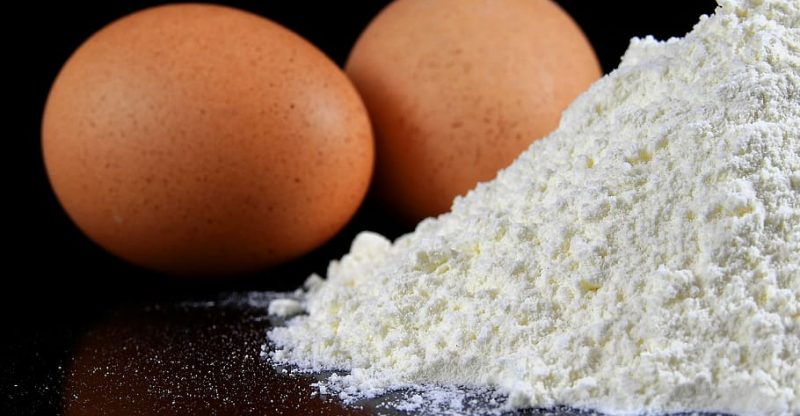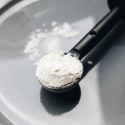Sodium Silicoaluminate (E554): What Is It, Uses and Side Effects

Sodium silicoaluminate or sodium aluminosilicate, an inorganic ingredient with low bulk density and high water absorption, used as an anticaking agent or free-flowing agent in food. E554 is its European food additive number.
Let’s dip into the navigation to know more:
What Is Sodium Silicoaluminate?
It refers to a series of amorphous hydrated sodium aluminium silicates with varying proportions of Na2O, Al2O3 and SiO2. Its purpose is to prevent powdered food from caking, lumping, or aggregation and keep its free-flowing property.
How Is It Made?
It is derived from the reaction of aluminum sulphate and sodium silicate followed by precipitation OR by reacting sodium metasilicate, metabisulfite, and aluminum sulfate through steam heating (1).
Properties
| Appearance | Fine white amorphous powder or beads. |
| Other names |
|
| CAS number | 1344-00-9 |
| Chemical formula | xSiO2 · yAl2O3 · zNa2O. Food grade complies with:
|
| Solubility | Insoluble in water; partially soluble in strong acids and alkali hydroxides. |
What Are The Uses?
Food grade sodium silicoaluminate can be used as an anticaking agent such as in table salts, dried whole eggs & egg yolks and grated cheeses. It functions as a replacement of titanium dioxide in some applications by a certain proportion due to their similar properties. Meanwhile, for its pore structure, strong hygroscopicity, and ultra-high whiteness, it is an ingredient used in wettable powder pesticides to substitute silica.
Is Sodium Silicoaluminate Safe?
Yes, its safety when used as a food additive has been approved by the U.S. Food and Drug Administration (FDA), European Food Safety Authority (EFSA), Joint FAO/WHO Expert Committee on Food Additives (JECFA), as well as other authorities.
FDA
It is generally recognized as safe (GRAS) when used as an anticaking agent at levels not exceed 2% in accordance with a good manufacturing practice. (2)
EFSA
Sodium aluminum silicate (E554) is listed in Commission Regulation (EU) No 231/2012 as an authorised food additive and categorized as “additives other than colours and sweeteners” (3)
Safety
In our body: it may be partly hydrolyzed in our digestive tract and release aluminum and silicate ions for which our oral absorption is low.
Toxicity: no skin or eye irritation, no carcinogenic, no genotoxic or teratogenic potential.
ADI: no need to set an acceptable daily intake (ADI). (4)
Authorised Uses
The following food may contain with it (5):
- Dried powdered foods
- Tablet and coated tablet form foods
- Sliced or grated cheese hard and semi-hard cheese
- Processed cheese
- Cheese product
- Table-top sweeteners in powder/tablets form
- Salt and salt substitutes
- Seasonings and condiments
- Food supplements supplied in a solid form/liquid form
- Fat soluble vitamin
UK Food Standards Agency
Categorized in “Others” (6)
Food Standards Australia New Zealand
It is an approved ingredient in Australia and New Zealand with the code number 554. (7)
JECFA
Function class: food additive, anticaking agent. (8)
Acceptable daily intake: Group ADI “not specific” set in 1985 for silicon dioxide and certain silicates. (9)
What Are The Possible Side Effects?
As an aluminum-containing food additive, it is common that sometimes consumers have questions whether sodium silicoaluminate is bad for our health and what are the possible health risks. It is generally considered safe but may be related to Alzheimers and other possible side effects.
Alzheimer’s disease
Aluminum is often associated with Alzheimer’s and other neurodegenerative diseases in humans. However, EFSA concluded that the intake of aluminum through food with a proper level is not a risk to develop Alzheimer’s disease. (10)
Possible Side Effects
It is found that aluminum compounds may have the following potential dangers in animals:
- Neurotoxicity in mice and rats
- Influence male reproductive system in dogs
- Embryotoxicity in mice
- Developing nervous in the offspring of mice and rats
Is It Safe For Pregnant?
Yes, it is generally safe but better consult with your doctor in the condition of use.
Frequently Asked Questions
Is It Natural?
No, obviously it is made from chemical synthesis as the manufacturing process mentioned above.
Is It Vegan?
Yes, it is vegan as the raw materials are from minerals instead of animal-derived:
Aluminum sulphate: manufactured by the reaction of aluminum hydroxide (derived from bauxite) and sulfuric acid (via the contact process of sulfur, oxygen and water).
Sodium silicates: produced by the reaction of silica (from diatomaceous earth) with caustic soda and water.
So it is vegan and suitable for the diet of vegetarians.
Is It Gluten Free?
Yes, the production process complies with the FDA’s definition of gluten free, that it does not contain wheat, rye, barley, or crossbreeds of these grains.
Conclusion
Now you may have a good knowledge of the anticaking agent – Sodium Silicoaluminate (E554), from its production; uses; approved safety, possible side effects and some FAQs such as is it vegan, gluten free, synthetic or natural.
What kinds of food packaging have you found this ingredient in? Let me know in the comments.



In cookies in a local bakery dept , Publix
It’s in Coffee Mate creamer
Does it contain sulfites
sulfites are not in the final product if made from the first method mentioned above. sulfites may present if from the second manufacturing process, but its content can be ignored.
Same reason I am here. CoffeeMate. I’ll probably stop using it anyway. I am highly disappointed to hear that it is in table salt, seasonings, and so many forms of cheese. I think the ONLY way to have a clean diet is home grown everything. It is SO so sad that the FDA has been purchased by “big food” years ago.
I found it in powdered dehydrated eggs. I have epilepsy and am concerned about the neurotoxicity of this additive.
It is in safeway home style beef gravy in jar
In hot chocolate powder and in a chocolate cake.
Silicoalumininate, in dried egg yolk, an ingredient in a Blueberry Scone
(Packaged by Morrison Healthcare for Mayo Clinic patients)
Is this really safe for our bodies longterm? Who wants any further chemicals fighting our health?
Why is it SO hard to buy fresh food made with natural foods in USA?
Hi Helen,
Maybe most people would like to have fresh and natural food, like the vegetables in our own garden. However, one question: 1.fresh food is not easy to store.
No offense, but some of the foods mentioned in these comments… I’d be more concerned about eating those foods than this additive. I mean..coffeemate? Powdered dehydrated eggs? Good whole foods are readily available everywhere these days, even at the lowly walmart. There’s no excuse for eating that crap but laziness.
“Why is it SO hard to buy fresh food made with natural foods in USA?” It’s not really. It’s has never been easier, nor cheaper actually. The problems is you’re used to eating convenience foods and not reading labels.
it’s in this:
🙁
Synacore Digestive Support Sticks For Cats 30 ct
Manufacturer: Van Beek Natural Science
Synacore for Cats is a digestive support and maintenance formula for cats. Daily symbiotic supplement containing enzymes, probiotics, prebiotics and vitamins. Synergistic formulation with 13 enzymes, 2 prebiotics, 2 probiotics, and 3 vitamins. These ingredients work together synergistically to proved the following benefits: promotes the overall well being of pets, provides nutritional support for a healthy immune system, moderates the negative effects of stress, helps support regular digestion; may protect against occasional digestive upsets and, may reduce fecal odor with regular use.
My question is… Does my body store these chemicals ? Do I have a way of flushing them out of my body? Why are these chemicals used in meat curing process, anti caking only?
Hi Todd,
No worries as almost all of approved food additives will be out of our body. You can see the packaging of your meat products to see what kinds of ingredients are involved.
How does this product (sodium silicoaluminate) differ from aluminum hydrosilicate? I know the latter is used in sodium chloride table salt to help pour, but in the body, it binds to the red blood cells and weights them down so they cannot carry 02 through the body easily. This causes blood pressure to go up and slows duplication of the red blood cells. They then develop sharp edges which cut into veins and arteries to cause atherosclerosis. So I wonder if these two products are similar?
I saw it on the bag containing Non-dairy creamer.
Found in Augason Farms Drief Egg. Powder. Too bad. I was looking for shelf-stable eggs.
Found it in Big Train [instant] Spiced Chai’s. Different flavors. So very disappointed, as it’s the best chai!
I’ll continue using Twinings Vanilla Chai tea bags, and experimenting with hot 2% milk.
I found it being used in some nacho-like snacks, Diana’s Toztecas, probably as an anticaking agent in the spices mix, it’s not specified but I presume as much.
I found it in food 4 patriots on their 25 year shelf life food. How disappointing. I guess if that’s all there is to eat then it won’t be a big deal ugh….
it’s in the salt of macdonalds fries
It’s in McDonald’s salt.
It’s in the Tim Hortons powdered french vanilla cappuccino can.
Found in Sysco iodized table salt packet
Wow! Yes I too found it’s in “survival” long term foods. Makes sense if they need it to last 25 years! There’s a myriad of these chemicals used to do this. As said above, if you’re truly starving, it won’t matter what you’ll eat!! They’ve purposely inundated us with these chemicals to ultimately cause illness and disease I’d say they’ve done a good job! It’s always the almighty dollar as the end result they’re looking at! Plus, we’re controlled more easily being sick. The ONLY way, maybe, to get away from these chemicals is to grow organically, hydroponically in Ph balanced, non polluted water, and then can your foods!! Our world is indundated with chemicals, pesticides, and nutrient deficiencies in our soils!
The red flag is that it safety as a food additive is based on limited consumption assumptions. Safety of consumption with multiple servings accross different proccessed food items is not questioned.
Aluminio que horror. Ganas de dañar ratas y ratones quizás humanos.
Found in fast food salt packets!
Augason Farms egg powder has this yummy ingredient. I guess I’ll be giving the stray cats scrambled aluminum until I run out. If I don’t get Alzheimer’s and forget too.
I give diatamatious earth to kill insects. treat it and it turns to glass. so is this stuff cutting up my capilaries and veins and causing plaque. give me kosher salt. none of this BS.
It is in the Gourmet Table brand iodized salt packets at Culver’s.